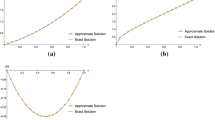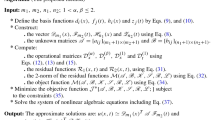Abstract
This paper introduces a general class of nonlinear system of fractional partial differential equations with initial and boundary conditions. A hybrid method based on the transcendental Bernstein series and the generalized shifted Chebyshev polynomials is proposed for finding the optimal solution of the nonlinear system of fractional partial differential equations. The solution of the nonlinear system of fractional partial differential equations is expanded in terms of the transcendental Bernstein series and the generalized shifted Chebyshev polynomials, as basis functions with unknown free coefficients and control parameters. The corresponding operational matrices of fractional derivatives are then derived for the basis functions. These basis functions, with their operational matrices of fractional order derivatives and the Lagrange multipliers, transform the problem into a nonlinear system of algebraic equations. By means of Darbo’s fixed point theorem and Banach contraction principle, an existence result and a unique result for the solution of the nonlinear system of fractional partial differential equations are obtained, respectively. The convergence analysis is discussed and several illustrative experiments illustrate the efficiency and accuracy of the proposed method.








Similar content being viewed by others
References
Hesameddini E, Shahbazi M (2019) Solving multipoint problems with linear Volterra–Fredholm integro-differential equations of the neutral type using Bernstein polynomials method. Appl Numer Math 136:122–138
Yüzbasi S (2016) A collocation method based on Bernstein polynomials to solve nonlinear Fredholm–Volterra integro-differential equations. Appl Math Comput 273(15):142–154
Wang J, Xu TZ, Wang GW (2018) Numerical algorithm for time-fractional Sawada–Kotera equation and Ito equation with Bernstein polynomials. Appl Math Comput 338:1–11
Asgari M, Ezzati R (2017) Using operational matrix of two-dimensional Bernstein polynomials for solving two-dimensional integral equations of fractional order. Appl Math Comput 307:290–298
Javadi Sh, Babolian E, Taheri Z (2016) Solving generalized pantograph equations by shifted orthonormal bernstein polynomials. J Comput Appl Math 303:1–14
Safaie E, Farahi MH, Farmani Ardehaie M (2015) An approximate method for numerically solving multi-dimensional delay fractional optimal control problems by Bernstein polynomials. Comput Appl Math 34(3):831–846
Chen Y, Yi M, Chen C, Yu C (2012) Bernstein polynomials method for fractional convection–diffusion equation with variable coefficients. CMES Comput Model Eng Sci 83:639–654
Behiry SH (2014) Solution of nonlinear Fredholm integro-differential equations using a hybrid of block pulse functions and normalized Bernstein polynomials. J Comput Appl Math 260:258–265
Vijender N (2019) Bernstein fractal trigonometric approximation. Acta Appl Math 159(1):11–27
Wang H, Zhang L (2018) Jacobi polynomials on the Bernstein ellipse. J Sci Comput 75:457–477
Zi-Qiang B, Yan G, Chia-Ming F (2019) A direct Chebyshev collocation method for the numerical solutions of three-dimensional Helmholtz-type equations. Eng Anal Bound Elem 104:26–33
Khatri Ghimire B, Tian HY, Lamichhane AR (2016) Numerical solutions of elliptic partial differential equations using Chebyshev polynomials. Comput Math Appl 72(4):1042–1054
Yang C (2018) Modified Chebyshev collocation method for pantograph-type differential equations. Appl Numer Math 134:132–144
Doha EH, Abdelkawy MA, Amin AZM, Lopes AM (2018) A space-time spectral approximation for solving nonlinear variable-order fractional sine and Klein–Gordon differential equations. Comput Appl Math 37(5):6212–6229
Ezz-Eldien SS, Wang Y, Abdelkawy MA, Zaky MA, Aldraiweesh AA, Tenreiro Machado J (2020) Chebyshev spectral methods for multi-order fractional neutral pantograph equations. Nonlinear Dynam 100:3785–3797
Pfeiffer BM, Marquardt W (1996) Symbolic semi-discretization of partial differential equation systems. Math Comput Simulat 42:617–628
Sun ZZ, Xu X (2006) A fully discrete difference scheme for a diffusion-wave system. Appl Numer Math 56:193–209
Gimena L, Gonzaga P, Gimena FN (2014) Boundary equations in the finite transfer method for solving differential equation systems. Appl Math Model 38:2648–2660
Singla K, Gupta RK (2016) On invariant analysis of some time fractional nonlinear systems of partial differential equations. I. J Math Phys 57(10):101504. https://doi.org/10.1063/1.4964937
Abdel-Halim Hassan IH (2008) Application to differential transformation method for solving systems of differential equations. Appl Math Model 32:2552–2559
Alliera CHD, Amster P (2018) Systems of delay differential equations: analysis of a model with feedback. Commun Nonlinear Sci Numer Simulat 65:299–308
Ablinger J, Blümlein J, Marquard P, Rana N, Schneider C (2019) Automated solution of first order factorizable systems of differential equations in one variable. Nucl Phys B 939:253–291
Ball JM (1983) systems of nonlinear partial differential equations. Springer, Berlin
Zaky MA (2020) Nonlinear systems of fractional differential equations and related integral equations with nonsmooth solutions. Appl Numer Math 154:205–222
Leon Pritchard F (2003) On implicit systems of differential equations. J Differ Equ 194:328–363
Feng TF, Chang CH, Chen JB, Zhang HB (2019) The system of partial differential equations for the \(c_0\) function. Nucl Phys B 940:130–189
Jaros J, Kusano T (2014) On strongly monotone solutions of a class of cyclic systems of nonlinear differential equations. J Math Anal Appl 417:996–1017
Guaily AG, Epstein M (2013) Boundary conditions for hyperbolic systems of partial differentials equations. J Adv Res 4(4):321–329
Filbet F, Xiong T (2018) A hybrid discontinuous Galerkin scheme for multi-scale kinetic equations. J Comput Phys 372(1):841–863
Menci M, Papi M (2019) Global solutions for a path-dependent hybrid system of differential equations under parabolic signal. Nonlinear Anal 184:172–192
Feib C, Shen M, Fei W, Mao X, Yan L (2019) Stability of highly nonlinear hybrid stochastic integro-differential delay equations. Nonlinear Anal Hybri 31:180–199
Dehao R, Jiaowan XL (2019) Stability of hybrid stochastic functional differential equations. Appl Math Comput 346(1):832–841
Chen C, Zhang X, Liu Z (2020) A high-order compact finite difference scheme and precise integration method based on modified Hopf–Cole transformation for numerical simulation of n-dimensional Burgers’ system. Appl Math Comput 372:125009
Zaky MA (2020) An accurate spectral collocation method for nonlinear systems of fractional differential equations and related integral equations with nonsmooth solutions. Appl Numer Math 154:205–222
Liu J, Hou G (2011) Numerical solutions of the space- and time-fractional coupled Burgers equations by generalized differential transform method. Appl Math Comput 217:7001–7008
Heydari MH, Avazzadeh Z (2020) Numerical study of non-singular variable-order time fractional coupled Burgers’ equations by using the Hahn polynomials. Eng Comput. https://doi.org/10.1007/s00366-020-01036-5
Sabir M, Shah A, Muhammad W, Ali I, Bastian P (2017) A mathematical model of tumor hypoxia targeting in cancer treatment and its numerical simulation. Comput Math Appl 74(12):3250–3259
Hendy AS, Zaky MA (2020) Graded mesh discretization for coupled system of nonlinear multi-term time-space fractional diffusion equations. Eng Comput. https://doi.org/10.1007/s00366-020-01095-8
Jafari H, Seifi S (2009) Solving a system of nonlinear fractional partial differential equations using homotopy analysis method. Commun Nonlinear Sci Numer Simul 14:1962–1969
Kreyszig E (1978) Introductory functional analysis with applications. Wiley, Hoboken
Seemab A, Remhman M (2020) Existence of solution of an infinite system of generalized fractional differential equations by Darbo’s fixed point theorem. J Comput Appl Math 364:112355
Sun S, Li Q, Li Y (2011) Existence and uniqueness of solutions for a coupled system of multi-term nonlinear fractional differential equations. Comput Math Appl 64:3310–3320
Kuratowski K (1939) Sur les espaces complets. Fund Math 15:301–309
Banas J, Goebel K (1980) Measures of Noncompactness in Banach Spaces, vol 60. Lecture Notes in Pure and Applied Mathematics. Dekker, NewYork
Roudin W (1976) Principles of mathematical analysis, 3rd edn. McGraw-Hill. Inc, New York
Gasea M, Sauer T (2000) On the history of multivariate polynomial interpolation. J Comput Appl Math 122:23–35
Author information
Authors and Affiliations
Corresponding author
Ethics declarations
Conflict of interest
The authors declare that they have no conflict of interest.
Additional information
Publisher's Note
Springer Nature remains neutral with regard to jurisdictional claims in published maps and institutional affiliations.
Rights and permissions
About this article
Cite this article
Hassani, H., Machado, J.A.T., Naraghirad, E. et al. Optimal solution of a general class of nonlinear system of fractional partial differential equations using hybrid functions. Engineering with Computers 39, 2401–2431 (2023). https://doi.org/10.1007/s00366-022-01627-4
Received:
Accepted:
Published:
Issue Date:
DOI: https://doi.org/10.1007/s00366-022-01627-4
Keywords
- General class of nonlinear system of fractional partial differential equations
- Hybrid method
- Transcendental Bernstein series
- Generalized shifted Chebyshev polynomials
- Control parameters




